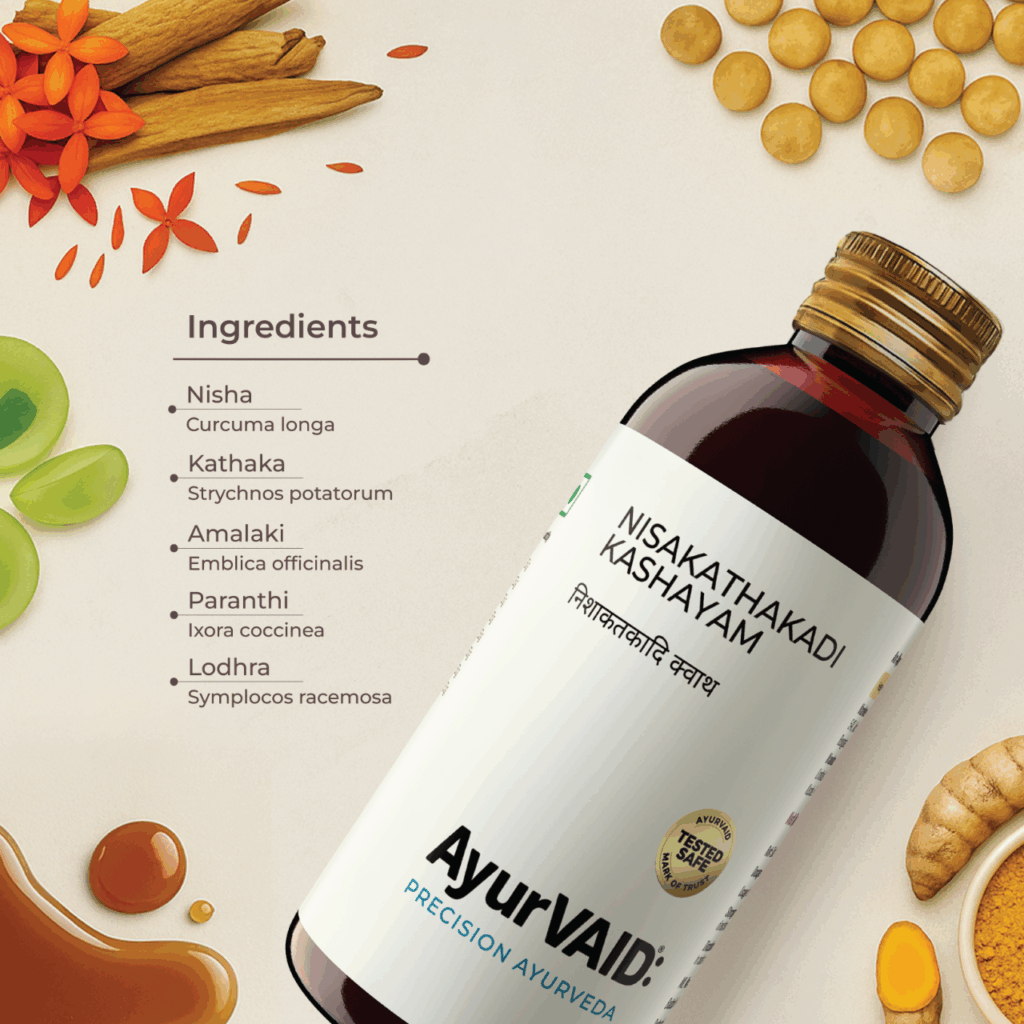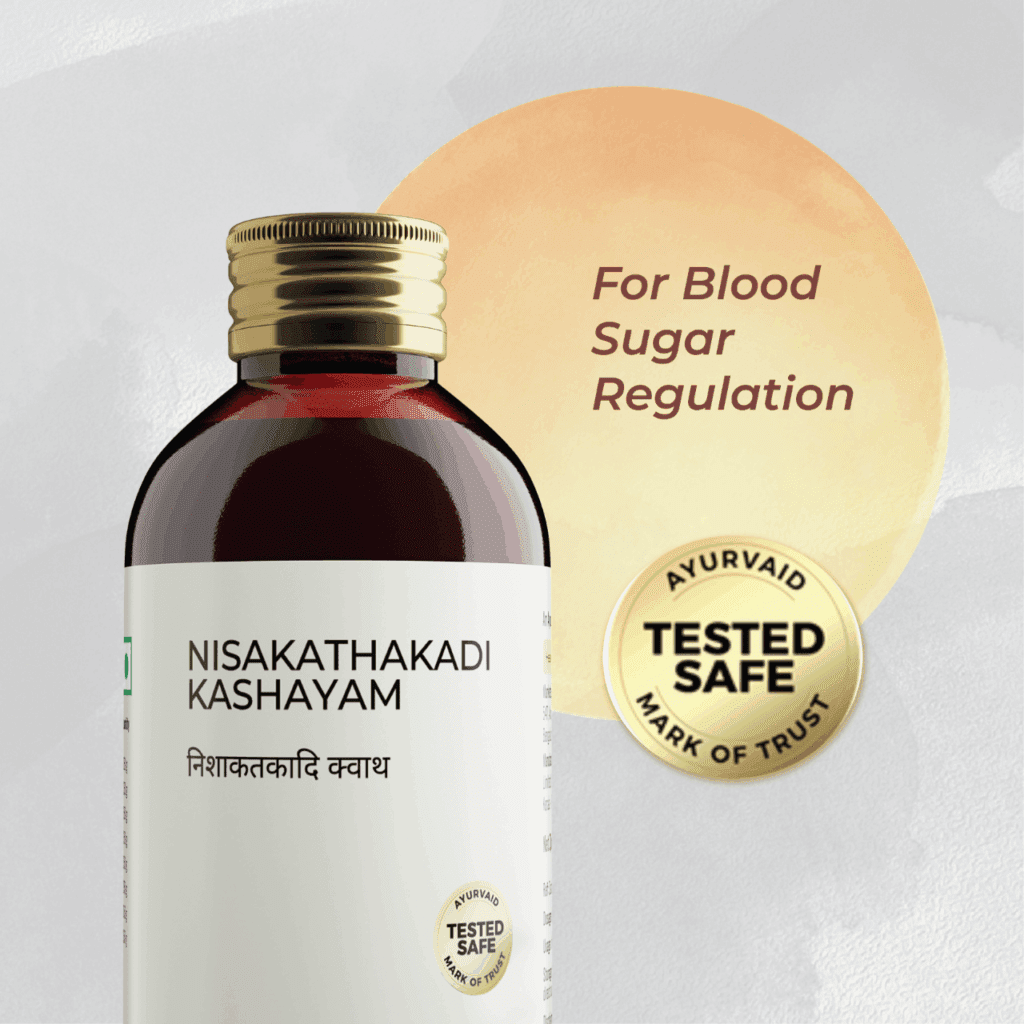Every November 14, the world pauses for a moment, as it’s World Diabetes Day. A day to think about a condition that touches millions of lives. Diabetes isn’t just “high sugar” on a report. No, it’s more complicated than that. It affects energy, sleep, mood… sometimes quietly, sometimes loudly.
Ever feel tired for no reason? Or thirsty, even after drinking water? Maybe you’ve noticed yourself rushing to the bathroom more often. These may seem like small clues to one’s health, but when ignored can lead to bigger issues.
This day is a reminder: managing diabetes isn’t only about pills or numbers. It’s about understanding your body, tuning in, and making small, mindful choices. And that’s where Ayurveda steps in. With herbs, lifestyle tweaks, and mindful habits, Ayurveda doesn’t just mask symptoms. It helps restore balance. Gently, steadily, naturally.
Understanding Prameha and Madhumeha
In Ayurveda, diabetes is called Prameha. Think of it as an umbrella term for around 20 urinary and metabolic disorders. Among them, Madhumeha stands out. It’s considered one of the eight major chronic diseases or Ashtamahagadas in classical Ayurveda, because it is difficult to treat and can gradually deplete the body.
The name is telling: Madhu means sweet or honey, and Meha means excessive urination. So right in the name, Ayurveda hints at one of the earliest signs: sugar in the urine and frequent bathroom trips. But it doesn’t stop at just naming the symptom. The real insight is deeper: Ayurveda looks at how your body’s doshas (Vata, Pitta, Kapha) interact with tissues (dhatus) and metabolic channels (srotas). Understanding this disease tree is essential to developing a comprehensive and customised plan to manage blood sugar effectively.

How Diabetes Develops (Samprapti) According to Ayurveda
Ayurveda sees two main ways diabetes can develop:
1. Obstruction-Type (Avaranajanya)
Excess Kapha and fat tissue (Meda Dhatu) obstruct Vata’s natural flow, and as a result, tissues are unable to absorb glucose effectively, insulin malfunctions, and the pancreas gradually deteriorates. It’s quite similar to Type 2 Diabetes Mellitus, particularly among overweight, sedentary individuals, and according to Acharya Vagbhata, it is considered Kricchsadhya (difficult to cure). Common causes are:
- Overeating heavy, oily, or sugary food habitually
- Lack of exercise and an inconsistent daily routine
- Sleeping at irregular times and ongoing emotional stress
- Genetic predisposition
2. Depletion-Type (Dhatukshayajanya)
Body tissues (dhatus), such as Majja (nervous tissue), Shukra (reproductive tissue), and Ojas (vital essence), deteriorate in both quality and quantity. This causes Vata imbalance, resulting in the person feeling weak, tired, losing weight, and having trouble with glucose metabolism. This presents in a typical case of Type 1 diabetes, or in advanced Type 2 diabetes, where the pancreas suffers from fatigue and insulin secretion decreases dangerously low.
The symptoms will include Prabhoota avila mutrata (Frequent, copious urination), Turbid urine due to abnormal components present, such as albumin, hyaline cast, red blood cells, and white blood cells, Polyuria, polyphagia, polydipsia, blurry vision, weakness, and recurrent infections.
Apollo AyurVAID: Precision Ayurveda for Diabetes Management
At Apollo AyurVAID, diabetes care blends traditional wisdom with modern tools. This isn’t just about numbers. It’s about:
- Balancing doshas and detoxifying metabolism
- Rebuilding tissues (Dhatu Poshanam)
- Making lifestyle changes in a sustainable manner
- Ongoing care to prevent complications
Our treatment plans may include:
- Tested Safe Ayurveda medicines – Herbal medicines that have Tikta (Bitter), Katu (Pungent), and Kasaya (Astringent) Rasa (tastes) that help to pacify Kapha & Meda (fat) tissue and are therefore hypoglycaemic. AyurVAID’s Nisakathakadi Kashayam is one of the best Ayurveda medicines for diabetes, which helps in natural blood sugar control and supports healthy glucose metabolism. Made with Turmeric, Amla (Emblica officinalis), Kataka, and other herbs, it helps to control high blood sugar levels, along with its complications of frequent urination, exhaustion, oedema of the feet, and burning or tingling sensations. Turmeric helps manage diabetes owing to its anti-inflammatory properties that help in managing normal blood glucose levels and also improve insulin sensitivity. Amla, on the other hand, combats oxidative stress and increases insulin responsiveness due to its high tannin content. This potent combination of herbs makes it an effective formulation for long-term management of high blood sugar.


AyurVAID Medicines are India’s First & Only TESTED SAFE Ayurveda line. Heavy metals, Aflatoxins, and Microbial Load individually are tested to fall well within the permissible limits in regular use and to API standards, and ensure Purity, Safety, and Therapeutic Integrity. All AyurVAID products are well-tested by NABL-accredited labs, and lab reports are available per batch via the QR code on the pack for instant access and utmost transparency and trust.
- Balancing the doshas: The goal of treatment is to reduce excess Kapha and Pitta, which are obstructing the normal flow of Vata (Avarana). Aggregation of Dushya (Meda Dhatu and Mamsa Dhatu) also creates a blockage to the flow of Vyana Vayu. Treatment targets the correction of this obstruction.
- Maintaining Ojas: Ojas (vital energy) is achieved by correcting the Apana Vayu and restoring metabolic homeostasis.
- Tissue rejuvenation: Treatment will also facilitate Rasayana therapy to rejuvenate the Dhatus (or tissues) and allow for holistic health.
- Addressing complications: Treatment of Madhumeha complications is also addressed with specific herbal formulations.
- Panchakarma detox therapies
- Diet and lifestyle tailored to you
- Yoga and stress management
Lifestyle and Dietary Tips
Ayurveda emphasises small, consistent habits. Healing isn’t a pill — it’s a lifestyle.
Daily Routine
- Wake early, move your body with gentle exercise or stretching
- Meditate, breathe deeply, and manage stress. Surya Namaskara, Ardha-Matsyendrasana, and Pawan-muktasana, along with Pranayamas such as Nadisodhan and Bhastrika, and Dhyana (meditation), are recommended.
- Keep a consistent sleep schedule
- Avoid long sitting spells
Dietary Recommendations
- Favour bitter, astringent, and pungent food, including karela (bitter gourd), methi (fenugreek), patola (pointed gourd), and rasona (garlic)
- Choose laghu ahara (light and easily digestible foods) and fibre-rich foods like barley, millet, ragi
- Avoid sugar, fried foods, excess dairy, and processed snacks as they cause derangement in carbohydrate and fat metabolism
- Eat warm, freshly prepared meals at regular times. Avoid Ghee, groundnut oil and soyabean oil.
- Sip lukewarm water and avoid drinking cold water.
Mindful Eating
- Slow down. Don’t rush your meals.
- Stop eating before you feel full.
- Express gratitude — it’s a tiny ritual with big effects on digestion and calmness.
Conclusion: Balance Over Numbers
Diabetes care is more than mere numbers. It’s about balance, awareness, and harmony. Instead of obsessing over hitting the “perfect” numbers on your blood test, Ayurveda takes a broader, more compassionate view: Herbs, therapies, mindful eating, and emotional well-being are all incorporated into Ayurveda’s roadmap to help you achieve holistic well-being.
With approaches like Apollo AyurVAID’s, you’re not only controlling your diabetes but also restoring your vitality, addressing imbalances, and establishing long-term health. Step by step, naturally and safely. This World Diabetes Day, take a moment to listen to your body. Notice the small signs, honour your energy, and make mindful choices. Because true care isn’t just about sugar levels—it’s about nurturing yourself, inside and out, every single day.






